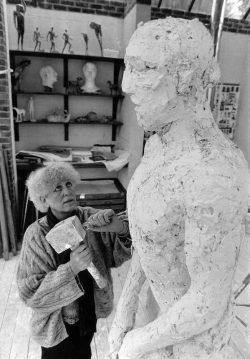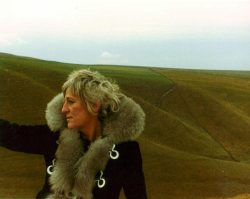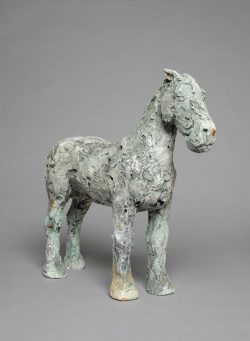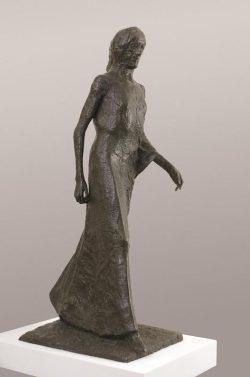 THE Dorset Museum at Dorchester is presenting a major exhibition of sculptor Dame Elisabeth Frink’s life and work, on until 21st April 2024. The works are drawn from the collection that Dorset Museum acquired from the Elisabeth Frink Estate in 2020, featuring sculptures, prints, drawings, and personal possessions. Many of these items, including working plasters that formed the basis of Frink’s bronze sculptures, will be on public show for the first time.
THE Dorset Museum at Dorchester is presenting a major exhibition of sculptor Dame Elisabeth Frink’s life and work, on until 21st April 2024. The works are drawn from the collection that Dorset Museum acquired from the Elisabeth Frink Estate in 2020, featuring sculptures, prints, drawings, and personal possessions. Many of these items, including working plasters that formed the basis of Frink’s bronze sculptures, will be on public show for the first time.
Arranged thematically, Elisabeth Frink: A View from Within will comprise around 80 works arranged in eight themed sections, each offering a unique perspective on Frink’s life and art, combining to reveal an intimate portrait of the celebrated sculptor. Coinciding with the 30th anniversary of the artist’s death, it will be the first exhibition to focus on the significant body of work produced by Frink (1930-1993) at her Woolland studio on Bulbarrow, in Dorset, between 1976 and 1993.
From her personal and artistic life at Woolland to a recreation of her studio, the artist’s creative methods will be explained, along with insights into her profound artistic vision. Through her sculptures the exhibition will explore her intimate connection with the natural environment; the contemplation of human-animal interdependence; spirituality and humanist beliefs; her dedication to human rights advocacy and finally her enduring legacy.
There will also be personal papers and photographs from the Frink Archive at the Dorset History Centre, and large-scale sculptures from Yorkshire Sculpture Park and The Ingram Collection of Modern British and Contemporary Art.
 Elizabeth Selby, Dorset Museum’s director of collections and public engagement, says: “Elisabeth Frink was an extraordinary artist who explored what it meant to be human through her work. This exhibition will portray Frink in a more intimate light, revealing her inner world and the major themes she explored in her sculpture, prints and drawings.”
Elizabeth Selby, Dorset Museum’s director of collections and public engagement, says: “Elisabeth Frink was an extraordinary artist who explored what it meant to be human through her work. This exhibition will portray Frink in a more intimate light, revealing her inner world and the major themes she explored in her sculpture, prints and drawings.”
The section Family and Social Life will focus on the Dorset home Frink shared with her husband Alex Csáky and will feature works that show both the personal and artistic aspects of her life at Woolland, as well as small personal objects; paintings created by friends; a book inspired by Elisabeth Frink written by her friend Michael Morpurgo; family photographs; and Seated Man (1986, loaned by Yorkshire Sculpture Park).
Particularly fascinating will be a partial recreation of Frink’s studio, complete with tools and the fragile plaster sculptures she made for casting in bronze. Plasters for sculptures including Walking Man (1989) and Leonardo’s Dog (1991), photographs and archive film will evoke the creative freedom she enjoyed in the privacy of her studio.
Printmaking will reveal the strength and fluency of Frink’s approach to drawing and how this influenced her printmaking and illustrations. A selection of original prints including Little Owl (1977) and Blue Horse Head (1988) shows how she mastered a number of printmaking techniques, lithography, etching and screen-printing. Book illustrations including The Children of the Gods, The Complete Myths and Legends of Ancient Greece will highlight how her art often echoed her love of poetry, music, reading and her deeply held beliefs.
 She created large sculptures, working in natural light and in all seasons within the extensive grounds of Woolland and against the backdrop of the Dorset hills and vales. My Garden is My Gallery will show that the dialogue between her work and the natural environment deepened her feelings regarding humanity and our impact on the world. Important works, including Riace III (1986, loaned by The Ingram Collection), and archive photographs will demonstrate new ways of working that became a major feature of her sculpture at this time.
She created large sculptures, working in natural light and in all seasons within the extensive grounds of Woolland and against the backdrop of the Dorset hills and vales. My Garden is My Gallery will show that the dialogue between her work and the natural environment deepened her feelings regarding humanity and our impact on the world. Important works, including Riace III (1986, loaned by The Ingram Collection), and archive photographs will demonstrate new ways of working that became a major feature of her sculpture at this time.
Frink’s deep interest in the relationship between humans and animals is explored in Interdependence of Species. Her belief in the dependency of humans on the natural world and other species, her questioning of hierarchies that lead to injustice and acts of aggression, will be considered through her sculptures of animals, including Standing Horse (1993) and Small Standing Dog (1991), drawings and original prints. Her untimely death prevented her from taking these ideas further in sculpture.
Spirituality and Humanism will examine Frink’s art in relation to her own spiritual beliefs and her commitment to humanist ideas. Raised as a Catholic, she expressed ambivalence towards organised religion, but a number of her sculptures, including Walking Madonna (1981, loaned by The Ingram Collection), demonstrate an understanding of litany and sacred space, while showing a sensibility and respect towards people with religious beliefs.
The Human Rights section will show her commitment to interrogating human rights abuses, revealing how her work gives dignity to the victims and survivors of brutality. She strove to find ways to present the tension between vulnerability and resilience, as in her Running Man watercolour (1976, loaned by the Ingram Collection) and her contribution to Amnesty International’s book Freedom (1980s). Her sculptural tributes to martyrs and prisoners of conscience will be a key focus, with Tribute III (1975) and a maquette figure for the Dorset Martyrs (1983), on display.
 The final section, New Beginnings, honours Frink’s enduring legacy, her relevance to modern life and world events, the influence she has had on successive generations of artists, and her continuing accessibility. The dying wishes of her son, Lin Jammet, were that the entire Frink Estate and Archive be given to the nation, ensuring that his mother’s vision of sharing her artwork within the public sphere was achieved. The Dorst Museum was one of 12 public museums across England, Scotland and Northern Ireland, that received artworks.
The final section, New Beginnings, honours Frink’s enduring legacy, her relevance to modern life and world events, the influence she has had on successive generations of artists, and her continuing accessibility. The dying wishes of her son, Lin Jammet, were that the entire Frink Estate and Archive be given to the nation, ensuring that his mother’s vision of sharing her artwork within the public sphere was achieved. The Dorst Museum was one of 12 public museums across England, Scotland and Northern Ireland, that received artworks.
Pictured: Elisabeth Frink on Bulbarrow Hill, Dorset, c.1970; courtesy of Dorset History Centre.
Elisabeth Frink working on the Dorset Martyr group, 1985; © Anthony Marshall/Courtesy of Dorset History Centre; artist copyright approved by Tully and Bree Jammet.
Standing Horse by Elisabeth Frink, 1993; Dorset Museum collection; artist copyright approved by Tully and Bree Jammet.
Walking Madonna by Elisabeth Frink, 1981 © John-Paul Bland; courtesy The Ingram Collection; artist copyrightapproved by Tully and Bree Jammet.